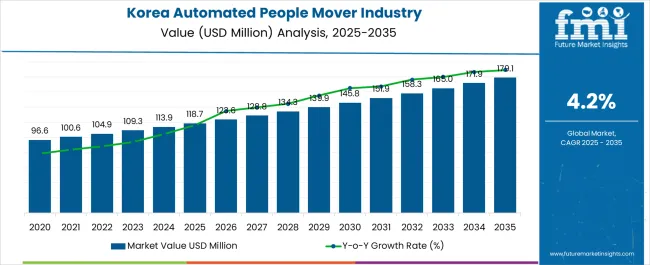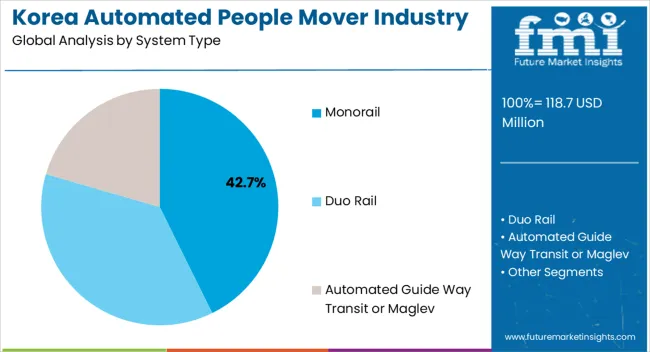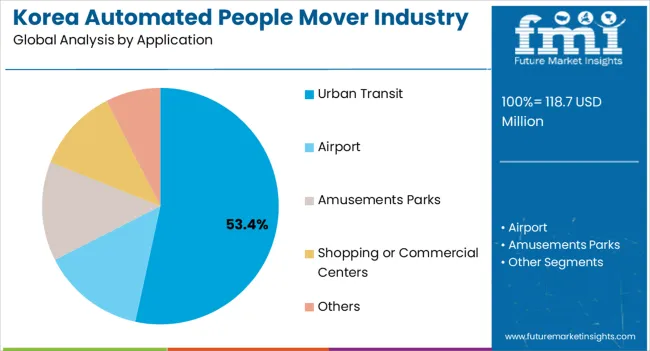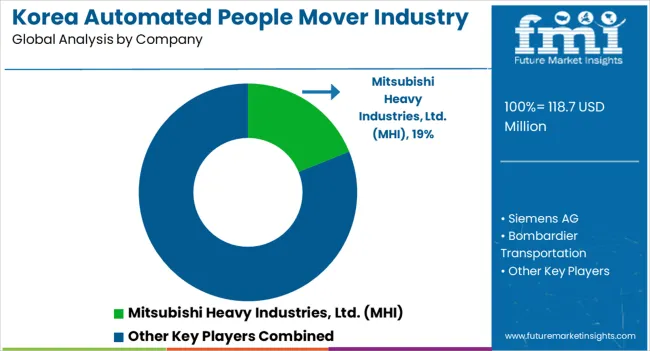The Korea Automated People Mover Industry is estimated to be valued at USD 118.7 million in 2025 and is projected to reach USD 179.1 million by 2035, registering a compound annual growth rate (CAGR) of 4.2% over the forecast period.

| Metric | Value |
|---|---|
| Korea Automated People Mover Industry Estimated Value in (2025 E) | USD 118.7 million |
| Korea Automated People Mover Industry Forecast Value in (2035 F) | USD 179.1 million |
| Forecast CAGR (2025 to 2035) | 4.2% |
The Korea automated people mover industry is expanding steadily. Growth is being supported by rapid urbanization, increasing need for efficient intra-city mobility, and ongoing investment in sustainable transport infrastructure. Current dynamics reflect rising deployment in airports, metro systems, and large commercial complexes.
Technological advancements in automation, safety systems, and energy efficiency are strengthening adoption. Regulatory support for eco-friendly transportation solutions and government-backed smart city initiatives are also driving market momentum. The future outlook is shaped by integration of digital monitoring, predictive maintenance, and connectivity-based operations, which are enhancing system reliability and reducing operating costs.
Growth rationale is centered on the role of automated people movers in reducing congestion, optimizing passenger flow, and improving connectivity across urban environments Expansion is expected to be sustained by infrastructure modernization, adoption of advanced monorail systems, and growing alignment with national sustainability targets, positioning the industry for long-term development.

The monorail segment, holding 42.70% of the system type category, has established itself as the leading segment due to its suitability for dense urban areas and cost-effective infrastructure deployment. Its elevated track design reduces land use requirements and enables seamless integration into existing cityscapes, which has strengthened its preference for urban transport projects.
The segment’s dominance is reinforced by advancements in automation and signaling systems that ensure safe, high-frequency operations. Operational efficiency, reduced noise, and low emissions are further driving adoption.
Government investments in sustainable transit infrastructure and public preference for convenient, eco-friendly solutions are expected to sustain demand Expansion of urban networks and alignment with smart mobility strategies are likely to ensure the segment maintains its leading position in the industry over the coming years.

The urban transit segment, representing 53.40% of the application category, has emerged as the dominant application due to increasing passenger demand for efficient and reliable intra-city travel. Market leadership is supported by the integration of automated people movers into metro networks and city-wide transport systems aimed at reducing congestion.
Strong government initiatives promoting mass transit adoption and sustainability are further reinforcing demand. The segment benefits from the ability of automated systems to provide high-capacity, frequent, and cost-effective transport solutions.
Technological innovations, including real-time monitoring and smart ticketing integration, are enhancing operational performance and passenger experience As urbanization accelerates and public infrastructure investments rise, urban transit applications are expected to sustain their dominant share and remain the primary driver of industry growth in Korea.
South Gyeongsang is experiencing a substantial increase in air passenger numbers, prompting airport planners to prioritize enhancing passenger transit efficiency within and between airline terminals and bolstering airport security measures. To alleviate congestion and streamline the passenger experience, cutting-edge transportation technologies, particularly autonomous people movers, are being implemented.
Manufacturers in North Jeolla are actively exporting these advanced transportation solutions globally. The growth of the North Jeolla transportation industry, fueled by the nationwide expansion of public transportation networks, positions it as a highly opportunistic industry for automated people mover.
The table below highlights that duo rail and airports segments are likely to lead the system and application category in 2025.
| Category | Industrial Share in 2025 |
|---|---|
| Duo Rail | 80.3% |
| Airports | 63.4% |
The duo rail segment is poised for significant growth, with a projected industrial share of 80.3%. Offering advantages in horizontal and vertical space utilization compared to traditional rail systems, duo rail systems feature broader vehicles elevated on slender support pillars, requiring minimal space. These attributes are expected to drive increased sales of duo rail systems in the coming years.
Within the airport segment is a substantial absolute dollar opportunity, commanding an industry share of 63.4%. Automated people mover system, integral to airport infrastructure, are crucial for efficiently transporting passengers between terminals, contributing to this segment's industrial share.

The competitive landscape for automated people mover in Korea is characterized by a strategic focus on innovation and efficiency. Key players employ expansion strategies, investing in research and development to enhance APM technologies.
Emphasis is placed on developing eco-friendly and energy-efficient solutions to support sustainability goals. Additionally, collaborations with urban development projects and airport expansions are pursued to capture industry share. The industry prioritizes customer-centric approaches, modifying APM systems to meet diverse urban transit needs.
Recent Developments Observed in Automated People Mover in Korea
| Attribute | Details |
|---|---|
| Estimated Industry Size in 2025 | USD 118.7 million |
| Projected Industry Size by 2035 | USD 179.1 million |
| Anticipated CAGR between 2025 to 2035 | 4.2% CAGR |
| Demand Forecast for Automated People Mover in Korea | 2025 to 2035 |
| Report Coverage | Industry Size, Industry Trends, Analysis of key factors influencing the Automated People Mover Industry in Korea, Insights on Global Players and their Industry Strategy in Korea, Ecosystem Analysis of Local and Regional Korea Providers |
| Key Provinces Analyzed while Studying Growth Opportunities for Automated People Mover in Korea |
South Gyeongsang, North Jeolla, South Jeolla, Jeju |
| Key Companies Profiled in the Analysis of Automated People Mover in Korea |
Siemens AG; Bombardier Transportation; Mitsubishi Heavy Industries, Ltd. (MHI); Hitachi, Ltd.; Thyssenkrupp; Doppelmayr Group |
The global Korea automated people mover industry is estimated to be valued at USD 118.7 million in 2025.
The market size for the Korea automated people mover industry is projected to reach USD 179.1 million by 2035.
The Korea automated people mover industry is expected to grow at a 4.2% CAGR between 2025 and 2035.
The key product types in Korea automated people mover industry are monorail, duo rail and automated guide way transit or maglev.
In terms of application, urban transit segment to command 53.4% share in the Korea automated people mover industry in 2025.






Full Research Suite comprises of:
Market outlook & trends analysis
Interviews & case studies
Strategic recommendations
Vendor profiles & capabilities analysis
5-year forecasts
8 regions and 60+ country-level data splits
Market segment data splits
12 months of continuous data updates
DELIVERED AS:
PDF EXCEL ONLINE
Korea Smart Home Security Camera Market Size and Share Forecast Outlook 2025 to 2035
Korea Bicycle Component Aftermarket Analysis Size and Share Forecast Outlook 2025 to 2035
Korea Calcium Supplement Market is segmented by form,end-use, application and province through 2025 to 2035.
The Korea Non-Dairy Creamer Market in Korea is segmented by form, nature, flavor, type, base, end-use, packaging, distribution channel, and province through 2025 to 2035.
Korea Women’s Intimate Care Market Analysis - Size, Share & Trends 2025 to 2035
Korea Conference Room Solution Market Growth – Trends & Forecast 2025 to 2035
Korea Visitor Management System Market Growth – Trends & Forecast 2025 to 2035
Korea fiber optic gyroscope market Growth – Trends & Forecast 2025 to 2035
Korea Event Management Software Market Insights – Demand & Growth Forecast 2025 to 2035
Korea Submarine Cable Market Insights – Demand & Forecast 2025 to 2035
Last-mile Delivery Software Market in Korea – Trends & Forecast through 2035
Korea HVDC Transmission System Market Trends & Forecast 2025 to 2035
Korea Base Station Antenna Market Growth – Trends & Forecast 2025 to 2035
Smart Space Market Analysis in Korea-Demand & Growth 2025 to 2035
Korea Banking-as-a-Service (BaaS) Platform Market Growth – Trends & Forecast 2025 to 2035
Korea I2C Bus Market Trends & Forecast 2025 to 2035
Korea On-shelf Availability Solution Market – Demand & Forecast 2025 to 2035
Korea Customized Premix Market Analysis – Size, Share & Trends 2025 to 2035
Korea Texturized Vegetable Protein Market Analysis – Size, Share & Trends 2025 to 2035
Korea Avocado Oil Market Analysis - Size, Share & Trends 2025 to 2035

Thank you!
You will receive an email from our Business Development Manager. Please be sure to check your SPAM/JUNK folder too.
Chat With
MaRIA